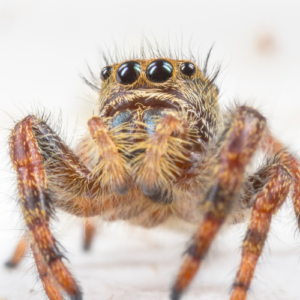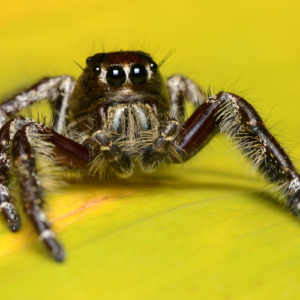
Do jumping spiders eat ants? Jumping spiders are those cute, furry and four-eyed creatures that are part of the arachnid world. Even the hardiest of arachnophobes can’t help but find themselves warming to these little beauties. The burning question here though, is do they eat ants?
Now that we’ve cleared that up, lets look more in depth into the fascinating world of the jumping spider.

What is a Jumping Spider?
Although they look like miniature tarantulas, a jumping spider is exactly that. A spider. They are called jumping spiders because, yep, you’ve guessed it, they jump.
Before it jumps, a jumping spider will tether a strand of silk to whatever it is standing on to protect itself from falling or making an incorrect jump.
Did you know that most jumping spiders can jump several times the length of their bodies? Pretty impressive, huh?
How Big are Jumping Spiders?
The average size of a jumping spider is 4-8 millimetres in length although the Hyllus giganteus, otherwise known as the giant jumping spider can grow up to 1.8–2.5 centimetres (0.71–0.98 in).
Where is the Best Place to Find a Jumping Spider?
Unless in captivity, jumping spiders live primarily in a number of places including gardens, fields, parks, and trees. They prefer open sunny areas with plenty of vegetation to hide and hunt within.
Are Jumping Spiders Aggressive?
As with all spiders, jumping spiders do have fangs. Unlike the more venomous spiders however, their bite is only comparable to a mosquito bite.
This is mainly due to the fact they as they are so small, their fangs aren’t big enough to leave a deep wound or any complications.
On the whole though, they are a very non-aggressive species.
Are Jumping Spiders Intelligent?
Although jumping spiders have a brain the size of a poppy seed, they are actually quite smart.
A new study shows that many species of jumping spider plan out intricate routes and detours to reach their prey — a quality usually observed in larger creatures.
Watch this adorable video of a man who has taught his jumping spider to give him a high-five.
Can Jumping Spiders See?
Unlike tarantulas who can see very poorly, and due to their four eyes, jumping spiders have impeccable eyesight to help them out. Their eyes focus on their prey, using image defocus to foster a sharp depth perception.
Their top two photoreceptor layers are ultraviolet sensitive, and the bottom two are sensitive to green light.
Do Jumping Spiders Make Webs?

Jumping spiders don’t utilize a web unlike the standard spider.
Instead, they hunt using their sharp sighting skills to spot their prey from far away, sneak closer and pounce it with their short and strong legs.
The Fencepost jumping spider sometimes catches prey that are much bigger than itself, including other spiders.
Do Jumping Spiders Burrow?
Jumping spiders are not generally burrowing spiders.
You may find them burrowing if they feel vulnerable, for example if they are in pre-molt. The habronattus pyrrithrix however, have been known to make heavily webbed burrows in their substrate.
Are Jumping Spiders Poisonous?
The jumping spider is far too small to be able to carry enough venom to be toxic to humans. Added to that their fangs are so tiny, they’re unable to leave a deep wound or pierce deep enough into the skin to do any real damage. As previously mentioned, a bite from a jumping spider is no worse than a mosquito bite.
How Many Types of Jumping Spider are There?
As of 2022, this family contains over 600 described genus and over 6,000 described species, making it the largest family of spiders at 13% of all species.
Everyone should be a huge fan of the jumping spider and hopefully, after reading this article, viewing the images and watching the small video, you will be too!
Now that you’ve read this article, maybe you’ll be interested in how long jumping spiders live?
Until next time, stay spidery!
